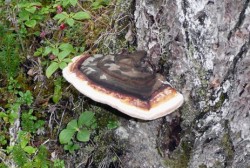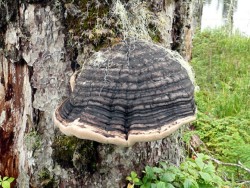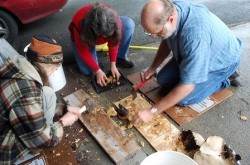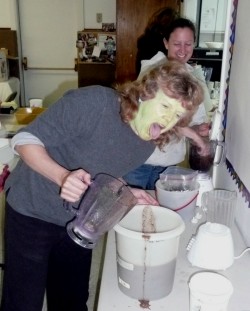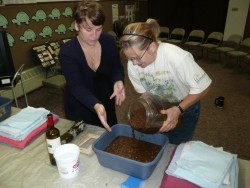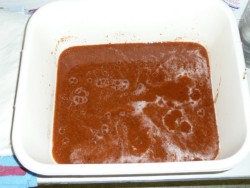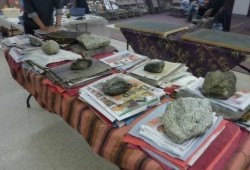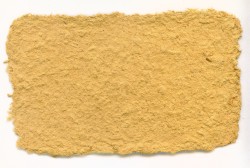Mushrooms for Color |
"The 3rd Annual Cordova Fungus Festival" was held in August 2009, to which I was again invited, this time to teach classes in "Polypore Paper Making" (see below) and "Making Myco-Stix", both arts that were pioneered by the indomitable Miriam C. Rice in Mendocino, California. Both of these workshops at the Cordova Fungus Festival were sponsored by The Alaska State Council on the Arts and the National Endowment for the Arts to which I am most grateful for giving me the opportunity to teach again in Cordova!
Once again, all of Cordova, Alaska, seemed to be involved in this affair – every other business had a poster in the window, fishermen, store owners and Forest Service folk were wearing "Cordova Fungus Festival" T-shirts… everywhere the enthusiasm was palpable and contagious. Dr. Steve Trudell from University of Washington, became the “lead mycologist”, but we also had local field biologists on hand – courtesy of the U.S. Forest Service, several members of whom are also avid dyers and knitters. |
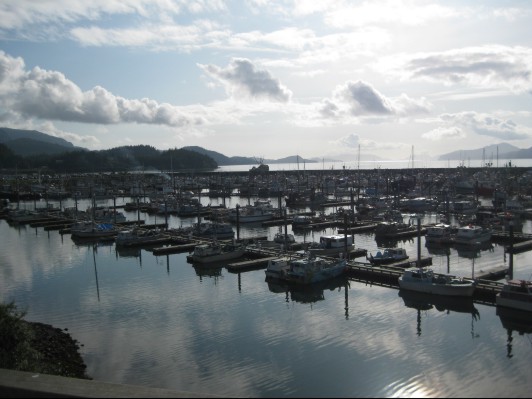 |
|---|
POLYPORES for PAPER inside on a rainy day in Cordova, Alaska |
||
Fometopsis sp. (Photo by Alan Marquette) |
Ganoderma sp. (Photo by Alan Marquette) |
Phellinus sp. (Photo by Alan Marquette) |
Some small unnamed black polypores (Conifera sp?) found in old logging area near Cordova promised intriguing possibilities.. (Photo
by Dorothy Beebee) |
The tough polypores had been soaked in buckets of water for about a week so that they would be easier to chop into as fine of pieces as possible before putting them into the blenders. (Photo by Amy O'Neill Houck) |
(Photo by Amy O'Neill Houck) |
Blending up the finely chopped fungi to make a "slurry" (Photo by Allen Marquette) |
Some of the polypores which had been soaking for a long time were rather odoriferous... (Photo by Allen Marquette) |
The blended slurry was poured into the basin. Stacks of felts, bottles and logs for "rolling pins", can be seen to side, all used to absorb and squeeze the water out from the paper-to-be. We used about 8 different polypores and as well as a few mushrooms left over from dyebaths. (Photo by Allen Marquette) |
Slurry ready for dipping, (above), and then draining the water off of the deckle and mould before flipping over the deckle and "couching" the paper. (Photo by Allen Marquette)
|
First, each basin was numbered, and a master list of matching number and name of fungus was created. Each participant had a chance to make paper from all of the different fungi, having a variety of experience in working with the various textures offered by each fungus. (Photo by Amy O'Neill Houck) |
Each participant had a chance to make paper from all of the different fungi, having a variety of experience in working with the various textures offered by each fungus. This was accomplished by each person making 1 or 2 sheets of paper from a basin of slurry, then moving on from basin to basin, each time initialing and numbering the cotton cloth upon which the paper was to dry.
Stacks of polypore paper, layered with felts and newspaper for absorbtion, were accumulated next to each basin of slurry. (Photo by Allen Marquette) |
The individually numbered stacks of felts and papers were then all gathered and weighted down with heavy rocks to squeeze out as much water as possible. (Photo by Amy O'Neill Houck) |
After the inital water was squeezed out of the paper, the extra layers of wet cloth, felt, and newspapers were removed. The individually numbered and initialed paper, still sitting on their original cotton cloths, were put onto screens to slowly dry. (Photo by Amy O'Neill Houck) |
Our rather elaborate and creative way of drying out all the little sheets of paper! At the end of the workshop, each person put their pieces of paper between some pages of dry newspaper to take home for further drying overnight. (Photo by Amy O'Neill Houck) |
A highly textured handmade paper created with Fometopsis pinicola polypores. (Photo by Dorothy Beebee)
|
Display of some of our polypore papers at the U.S.F.S. building in Cordova, Alaska (Photo by Allen Marquette) |
Silky smooth handmade paper created with leftover dyebath detritus of Phellodon atrata mushrooms. (Photo by Allen Marquette) |
Once again, I offer my sincerest thanks to Erin Cooper for organizing and inviting me to teach the "Papermaking" and "Myco-Stix" workshops, and to Allen and Susanna Marquette for being my most generous hosts at their home in Cordova! ~ Dorothy Beebee
